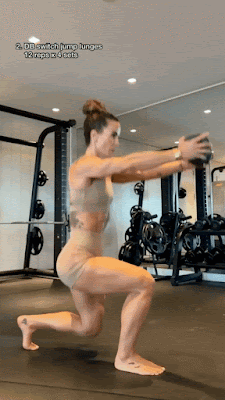Unleash Your Strength: The Ultimate Full Body Workout for Women
Achieving a toned and strong physique is a common goal for many women, and a well-rounded full body workout can be the key to success. In this article, we'll explore an effective full body workout routine tailored specifically for women. Whether you're a beginner or an experienced gym-goer, this comprehensive workout will help you build strength, increase endurance, and sculpt your body from head to toe.
Warm-Up:
Before diving into the workout, it's essential to warm up your muscles and prepare your body for exercise. Spend 5-10 minutes performing dynamic stretches and light cardio activities such as jogging, jumping jacks, and arm circles. This will increase blood flow to your muscles, improve flexibility, and reduce the risk of injury.
The Workout:
1. Squats: 3 sets of 12 reps
Stand with your feet shoulder-width apart, toes slightly turned out. Lower your body as if sitting back into a chair, keeping your chest lifted and knees tracking over your toes. Push through your heels to return to the starting position.
2. Push-Ups: 3 sets of 10 reps
Start in a plank position with your hands shoulder-width apart and your body in a straight line from head to heels. Lower your chest towards the ground by bending your elbows, then push back up to the starting position.
3. Bent-Over Rows: 3 sets of 12 reps
Hold a dumbbell in each hand with your palms facing your body. Hinge at the hips and bend your knees slightly, keeping your back flat. Pull the dumbbells towards your chest, squeezing your shoulder blades together, then lower them back down with control.
4. Lunges: 3 sets of 10 reps per leg
Step forward with one foot and lower your body until both knees are bent at a 90-degree angle. Keep your front knee tracking over your ankle and your back knee hovering just above the ground. Push through your front heel to return to the starting position, then repeat on the other side.
5. Plank: 3 sets, hold for 30-60 seconds
Start in a plank position with your elbows directly beneath your shoulders and your body in a straight line from head to heels. Engage your core muscles and hold this position, focusing on maintaining proper form and breathing deeply.
6. Russian Twists: 3 sets of 15 reps
Sit on the ground with your knees bent and your feet flat on the floor. Lean back slightly and lift your feet off the ground, balancing on your sit bones. Hold a dumbbell or medicine ball in front of your chest and rotate your torso from side to side, touching the weight to the ground with each twist.
Cooldown:
After completing the workout, take a few minutes to stretch your muscles and allow your heart rate to return to normal. Focus on stretching the major muscle groups used during the workout, including your legs, arms, chest, back, and core.
This full body workout for women is designed to target all the major muscle groups, providing a balanced and effective strength training routine. Incorporate this workout into your fitness routine 2-3 times per week, allowing for adequate rest and recovery between sessions. With consistency and dedication, you'll be well on your way to achieving your fitness goals and feeling stronger and more confident in no time.





.gif)
.gif)

